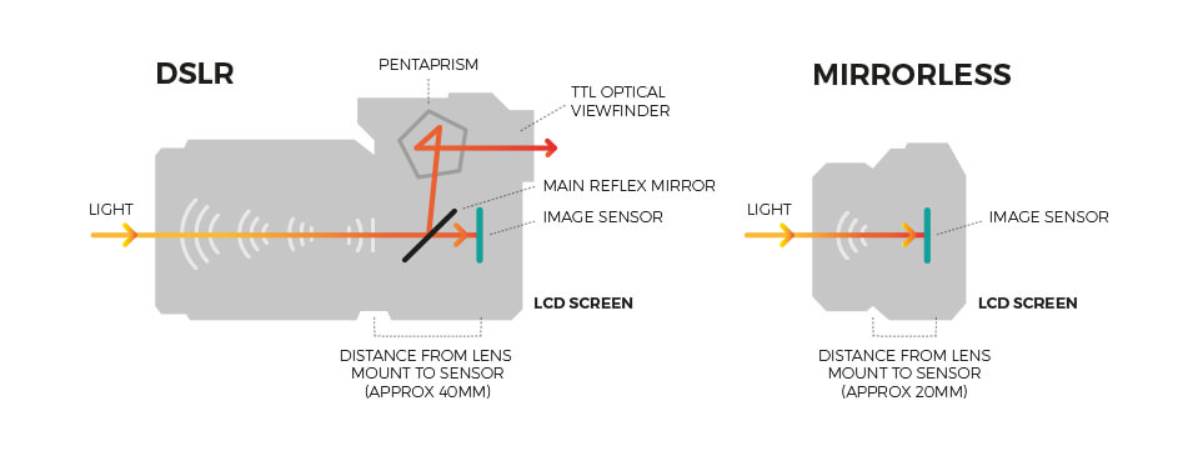A mirrorless camera works by using a digital image sensor to capture light instead of a mirror. Light enters the lens and hits the sensor, creating a digital image that is displayed on the camera’s electronic viewfinder or LCD screen.
This technology allows for a more compact and lightweight camera body compared to traditional DSLR cameras, making mirrorless cameras popular among photographers seeking portability and high image quality. With advancements in mirrorless technology, these cameras now offer features like fast autofocus, in-body image stabilization, and 4K video capabilities.
Mirrorless cameras have become a versatile tool for both professionals and hobbyists looking to capture stunning photos and videos with ease.

Credit: global.canon
Key Components Of A Mirrorless Camera
Mirrorless cameras operate without a traditional mirror mechanism found in DSLRs. Light passes directly through the lens to the image sensor, resulting in a compact design and real-time electronic viewfinder. Key components include the sensor, processor, lens mount, and electronic viewfinder.
This innovative technology offers versatility and high-quality image capture.
In order to understand how a mirrorless camera works, it is important to delve into its key components. These components are responsible for the seamless operation and high-quality results that mirrorless cameras are famous for. Let’s take a closer look at the main elements that make up a mirrorless camera.Image Sensor
The image sensor is a crucial component of a mirrorless camera. It is responsible for capturing light and converting it into digital information, effectively creating the image. Without a high-quality image sensor, the resulting photos or videos would lack detail and clarity. Mirrorless cameras usually employ either the larger full-frame sensors or smaller APS-C or Micro Four Thirds sensors. The choice of sensor size depends on the camera’s intended purpose and the desired level of image quality.Electronic Viewfinder
Unlike traditional DSLR cameras that employ an optical viewfinder, mirrorless cameras utilize an electronic viewfinder (EVF). This advanced feature allows photographers to preview the image in real-time, exactly as it will appear in the final photo or video. The EVF is directly connected to the image sensor, providing an accurate representation of how the exposure, white balance, and other settings affect the image before it is captured. This enhances the user experience by eliminating the need for guesswork and allowing for precise adjustments.Lens Mount
The lens mount is the connection between the camera body and the interchangeable lens. Mirrorless cameras often have a wide range of lens options, thanks to a diverse selection of lens mounts available in the market. Different camera manufacturers have their own proprietary mounts, each designed to accommodate their respective lens systems. From standard prime lenses to versatile zoom lenses and specialized macro lenses, the lens mount plays a crucial role in expanding the creative capabilities of a mirrorless camera.Image Processor
The image processor is the powerhouse of a mirrorless camera. It is responsible for handling and processing the data captured by the image sensor, converting it into a finished image or video file. A powerful image processor allows for faster continuous shooting, better noise reduction, and improved overall image quality. It also enables the camera to handle advanced features such as high-resolution video recording and various creative shooting modes. Each camera model has its own specific image processor, and advancements in image processing technology continue to push the boundaries of mirrorless camera capabilities. In conclusion, the key components of a mirrorless camera – the image sensor, electronic viewfinder, lens mount, and image processor – work in harmony to produce outstanding images and videos. Understanding how these components contribute to the overall performance of a mirrorless camera can help photographers make informed choices when selecting the right camera for their needs. With continuous advancements in technology, mirrorless cameras are becoming increasingly powerful and versatile, offering an exciting alternative to traditional DSLR cameras.
Credit: global.canon
Advantages Of Mirrorless Cameras
Mirrorless cameras have gained significant popularity due to their innovative technology and impressive features. Let’s explore some of the key advantages that make mirrorless cameras stand out in the world of photography.
Compact Size And Portability
Mirrorless cameras are notably smaller and lighter than traditional DSLR cameras, making them incredibly portable. This compact size makes them ideal for travel, street photography, and any situation where carrying less bulk is preferable. Photographers can enjoy capturing high-quality images without the burden of heavy equipment.
Fast Autofocus
The advanced autofocus systems in mirrorless cameras enable swift and accurate focusing, even on moving subjects. This is particularly beneficial for capturing action shots, wildlife, and sports photography. The responsive autofocus mechanism ensures that photographers can seize the perfect moment with precision and ease.
Silent Shutter
Unlike DSLR cameras, mirrorless models feature a silent shutter mechanism, which eliminates the loud noise associated with traditional cameras. This discreet operation is advantageous in quiet environments, such as weddings, events, and wildlife photography, where maintaining a low profile is crucial.
Ability To Adapt To Different Lenses
Mirrorless cameras offer a wide range of lens adaptability, allowing photographers to explore various focal lengths, apertures, and styles. This flexibility enables creative freedom and the ability to customize the camera setup for specific shooting scenarios, such as landscape, portrait, macro, or low-light photography.
Disadvantages Of Mirrorless Cameras
limited Battery Life
Mirrorless cameras have limited battery life due to the electronic components.
electronic Viewfinder Lag
There may be a slight lag in the electronic viewfinder, affecting real-time shooting.
less Lens Options Compared To Dslrs
Mirrorless cameras tend to offer fewer lens options than traditional DSLRs.

Credit: orah.co
Conclusion
A mirrorless camera operates by using a digital image sensor to capture light. This innovative technology eliminates the need for a mirror and optical viewfinder. As a result, mirrorless cameras are lighter, more compact, and offer advanced features. Understanding how these cameras work can help you make an informed decision when choosing the right camera for your needs.


0 comments